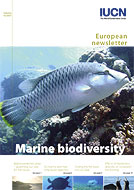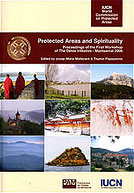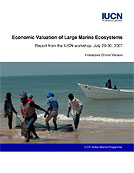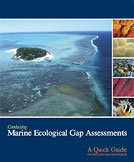

 |
||
 |
||
Vol. 11 (1): June 2008 |
||
Reversible absenceThe government of the Balearic Islands, Spain, has published a lavishly illustrated, 150-page book dedicated to the Mediterranean monk seal. Written by Joan Mayol, of the Endangered Species Service of the government, the edition covers the history of the species among the islands, its persecution and decline, and the steps that have been taken to encourage its return, including the establishment of the Cabrera National Park.
The edition is published in four languages: Catalan, Spanish, English and German. Thanks to the author and publisher, a PDF version of the book is being made available for download from the TMG Library [see ‘Further information’ below]. In introducing the book, the Conseller de Medi Ambient, Miquel Àngel Grimalt Vert, notes that attitudes towards monk seals and the natural environment have changed radically since the species became extinct in the islands. “The people who, at a quite different moment in history from the present, killed the last of the seals were in all likelihood the object of the admiration of their contemporaries,” writes Grimalt Vert. “Nowadays, the opposite would be true: the social scale of values has been completely reversed, and we see in this animal a magnificent, living symbol of the integration of nature in the Mediterranean in all its grandeur. This is why it is important to make all possible contributions to the recovery of this species, increasing even further the interest and the attention given to it in the Balearics, and facilitate its return to waters from which it should never have been expelled. Let us hope, as the title of the book suggests, that this truly be a reversible absence!” Those wishing to obtain a hardcopy of the book can do so by contacting the publisher, Baltar, by email at . The cost is €15.- plus delivery. Further informationMayol, Joan. 2008. El vell marí, una absència reversible. The monk seal, a reversible absence. Conselleria de medi ambient del govern de les Illes Balears. In Catalan, Spanish, English and German: 1-51. [PDF
|
 |
|
 |
|
 |
|
 |
|
|
|
IUCN. 2007. European Newsletter. Marine biodiversity, vol. 13 (2007): 1-16. [PDF ![]() 848KB].
848KB].
Includes an overview of the EU-funded project seeking to mitigate seal-fishery interactions in Greece, by Spyros Kotomatas of MOm, and “New Initiatives for the Monk Seal,” by Hemmo Muntingh, Senior Policy Advisor of IFAW, on an international framework for monk seal conservation.
IUCN. 2007. Protected Areas and Spirituality: Proceedings of the First Workshop of the Delos Initiative: 1-327. [Info]
The Delos Initiative focuses on the sacred natural sites in developed countries throughout the world, including Europe and the USA. Its main purpose is to help in maintaining both the sanctity and the biodiversity of these sites, through the understanding of the complex relationship between spiritual/cultural and natural values. This publication includes all presentations made at the First Workshop of the Delos Initiative, which took place in Montserrat in 2006. All speeches delivered and case studies presented at the workshop have been included, as well as conclusions and lessons learned.
IUCN. 2007. Economic Valuation of Large Marine Ecosystems. Report from the IUCN workshop, July 29-30, 2007: 1-18. [PDF ![]() 132KB]
132KB]
Discusses the methods, advantages and pitfalls, of valuating marine ecosystems for the purposes of conservation and sustainable development.
MEDPAN, IUCN, UNEP. 2007. Port-Cros Declaration, 26 October 2007: 1-3. [PDF ![]() 132KB]
132KB]
Experts attending the First Conference of the Network of Marine Protected Areas in the Mediterranean (MedPAN), held at the Port-Cros National Park in France in October 2007, adopted the Port-Cros Declaration, calling for swifter action to create a coherent, representative, and effectively managed network of MPAs in the Mediterranean Sea by 2012 to halt loss of biodiversity and to meet conservation targets. The Declaration was signed by 110 field experts and protected area managers, as well as IUCN, WWF and the Regional Activity Centre for Specially Protected AreasRAC/SPA. Proceedings of the conference are available at www.medpan.org.
MEDPAN, RAC/SPA, IUCN, WWF. 2008. Supporting the development of a representative, effective network of MPAs in the Mediterranean Sea, Almería, 16 January 2008: 1-50. [PDF ![]() 2.8MB]
2.8MB]
Among other pressing issues, the Almería Conference proceedings ponder the current status of MPAs in the Mediterranean Sea, and recommendations for future action.
Nature Conservancy. 2007. A quick guide to conducting marine ecological gap assessments. A quick guide for protected area managers: 1-21 pages. [PDF ![]() 1.2MB]
1.2MB]
EndQuoteEarth losing 3 species an hour, UN says OSLO – Human activities are wiping out three animal or plant species every hour and the world must do more to slow the worst spate of extinctions since the dinosaurs by 2010, the United Nations said Tuesday. […] “Biodiversity is being lost at an unprecedented rate,” UN Secretary-General Ban Ki-moon said in a statement. Global warming is adding to threats such as land clearance, pollution and rising human populations. “The global response to these challenges needs to move much more rapidly, and with more determination at all levels,” he said. Many experts reckon the world will fail to meet the goal set by world leaders at an Earth Summit in 2002 of a “significant reduction” by 2010 in the rate of species losses. “We are indeed experiencing the greatest wave of extinctions since the disappearance of the dinosaurs,” said Ahmed Djoghlaf, head of the UN Convention on Biological Diversity. Dinosaurs vanished 65 million years ago. “Extinction rates are rising by a factor of up to 1,000 above natural rates. Every hour, three species disappear. Every day, up to 150 species are lost. Every year, between 18,000 and 55,000 species become extinct,” he said. “The cause: human activities.” […] The World Conservation Union also said that one in every six land mammals in Europe was under threat of extinction, including the Iberian lynx, Arctic fox and the Mediterranean monk seal. […]
|
Copyright © 2008 The Monachus Guardian. All Rights Reserved |